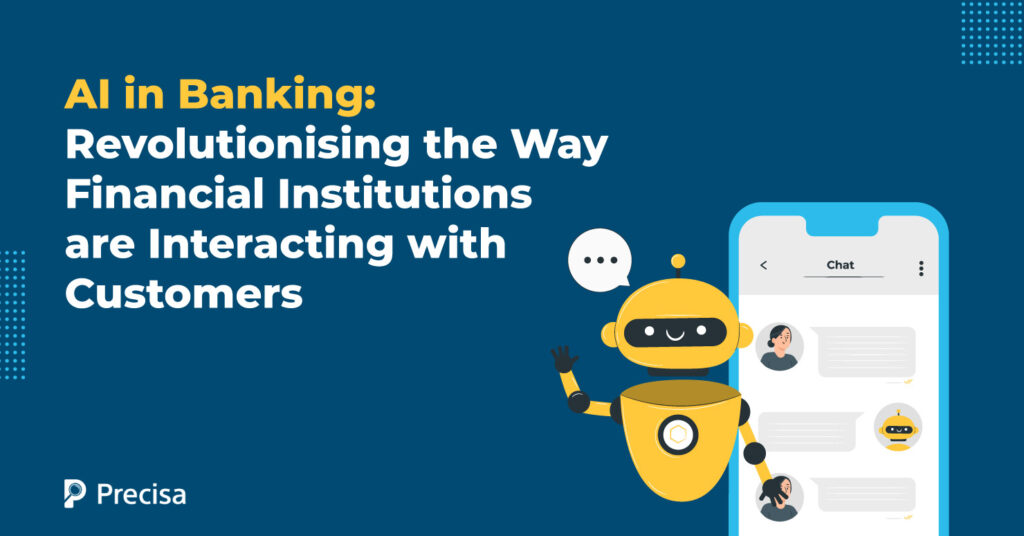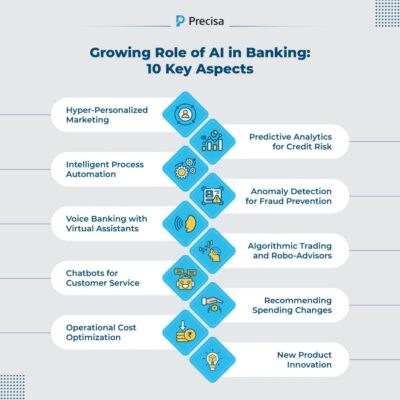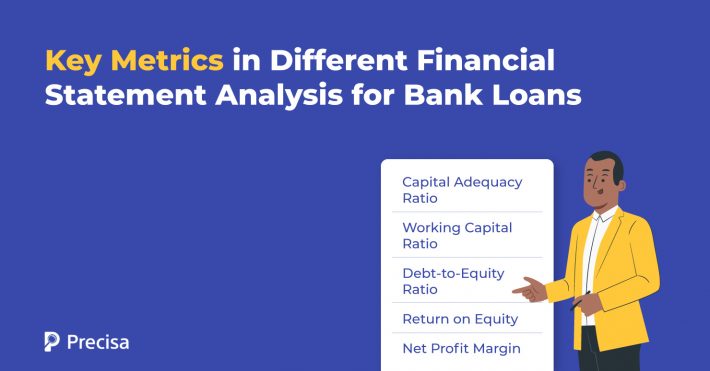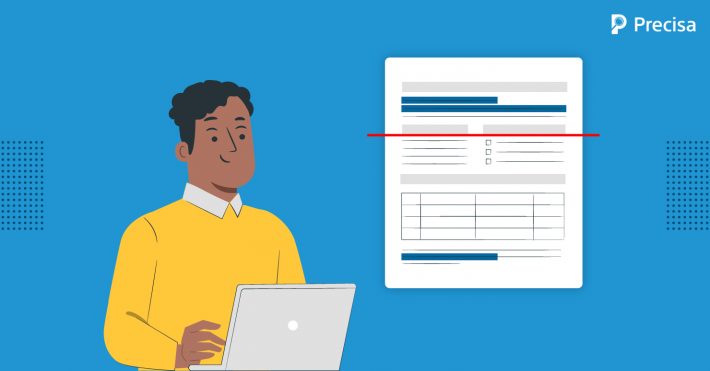AI in Banking: Chatbots, Robo-Advisors, and Beyond

The banking industry is on the cusp of a revolution driven by emerging technologies like artificial intelligence (AI) and machine learning. From chatbots to robo-advisors, AI in banking will change the way financial institutions interact with customers and operate internally.
As per Allied Market Research estimates, the global AI in banking market size stood at $3.88 billion in 2020, and it’s projected to skyrocket to $64.03 billion by 2030.
By 2028, the industry expects to see 30% employee productivity gains across front and back-office operations through AI-driven automation.
Recently, many banks have begun implementing AI-powered chatbots and virtual assistants to handle frequently-posed customer queries. Additionally, robo-advisors (algorithmic portfolio managers) provide automated financial planning and wealth management guidance without any human intervention.
While chatbots focus on customer interactions and robo-advisors specifically address investments, these are just initial applications of AI in finance. This blog post explores the growing role of AI in banking and how it creates value across the industry.
Growing Role of AI in Banking: 10 Key Aspects

Artificial intelligence is driving transformational impact across nearly every facet of banking – spanning front, middle and back-office functions.
By infusing processes with data-driven intelligence, banks stand to realise tremendous efficiency gains, deepen customer connectivity, mitigate risks, spawn innovation and build competitive advantages. Core application areas where AI is creating value include:
- Hyper-personalised marketing
- Predictive analytics for improved decision making
- Process automation
- Fraud analytics
- Conversational platforms
Let’s explore some of the specific ways AI in banking is set to revolutionise the sector:
1. Hyper-Personalized Marketing
Banks hold rich customer data spanning demographics, transactions, payments history, risk profiles, and cross-product relationships. By applying AI algorithms to this data, banks can analyse consumption patterns and build detailed customer profiles.
These insights enable ultra-targeted and relevant marketing promotions tailored to each individual based on their unique needs and behaviours. This hyper-personalized approach aligned to micro-segmented clusters yields much higher campaign response rates.
2. Predictive Analytics for Credit Risk
Banks can apply machine learning algorithms to analyse alternative data from various sources to build smarter credit risk scoring models, which is especially useful when lending to thin-file customers with minimal formal credit history.
Note the following examples of data sources which can reveal patterns and insights to determine creditworthiness more holistically:
- Rental payment histories
- Insurance claims, job stability metrics
- Other non-traditional credit information
AI in banking helps surface these relationships within large datasets that would be nearly impossible to detect manually.
3. Intelligent Process Automation
By harnessing techniques like computer vision, speech recognition, and natural language processing, AI in banks can automate high volumes of repetitive back-office tasks that are currently handled manually. This assists in improving productivity, speed, and accuracy while reducing errors and allowing bank employees to focus on higher-value, customer-facing roles.
Common use cases range from contract parsing, claims processing, and data entry to various customer support activities.
4. Anomaly Detection for Fraud Prevention
By combining analysis of transaction data, geo-location signals from mobile devices, and customer profile information, AI models can identify suspicious and anomalous events in real-time. This helps spot potential fraud faster than legacy approaches, which rely on manual, rule-based protocols. AI in banking can reduce overall risk exposure, both financially and reputationally.
5. Voice Banking with Virtual Assistants
The growing adoption of AI-based smart speakers and virtual assistants like Alexa, Siri and Google Assistant has given rise to voice banking capabilities. Banks are beginning to roll out services that allow retail and commercial customers to conduct routine transactions via conversational voice commands.
For example, checking account balances, paying bills, funds transfers and trade orders. With conversational capabilities, AI in banking improves customer experience while advancing accessibility.
6. Algorithmic Trading and Robo-Advisors
Robo-advisors provide automated portfolio management services to retail investors by using algorithms that determine ideal fund allocations tailored to risk appetite and financial goals.
Similarly, banks are producing AI to power stock trading decisions by using advanced machine learning algorithms which continuously analyse vast quantities of market data, pricing indicators and risk metrics to optimise trade timing, execution, and settlement and recommend actions to human traders, augmenting their capabilities.
7. Chatbots for Customer Service
AI-powered chatbots are gaining rapid adoption to improve and personalise customer experience. Customers can get instant 24/7 assistance for the following services through conversational text and voice interactions rather than calling help centres or visiting branches:
- Checking balances
- Tracking payments
- Disputing transactions
- Making transfers or reorders
As chatbots handle increasing volumes of routine queries, they improve in scope while banks can reserve human agents for addressing higher complexity issues and advisory/sales conversations.
8. Recommending Spending Changes
Based on analysis of customers’ income streams, current account balances and historical spending patterns across transaction categories, banks can leverage AI to provide personalised tips and recommendations to improve financial habits.
For instance, flagging unusual spending trajectories, identifying potential savings from subscriptions, and budget changes to achieve savings goals faster or avoid potential overdraft fees. AI in banking can help improve customer’s overall financial health.
9. Operational Cost Optimization
To optimise processes and reduce operating costs across the enterprise, banks are applying advanced analytics and AI across various functions.
Use cases include better demand forecasting to optimise capacity planning, streamlining supply chain logistics by leveraging IoT data, automating fraud analytics to reduce losses, and using end-to-end process mining to automate manual efforts.
10. New Product Innovation
By continuously analysing market trends, competitive offers and customer needs, banks can use AI to spark ideas for designing differentiated products and value-added services that fill portfolio gaps. Banks could also run simulations to model uptake for new offerings prior to launch.
Final Note
AI in banking is fundamentally revolutionising the financial sector in multiple ways. The future competitive landscape will be determined by how creatively banks leverage these technologies to reduce costs, deepen customer relationships, uncover new revenue opportunities, and position themselves at the forefront of innovation.
If you’re a lender looking to infuse AI in your work, Precisa offers smart bank statement analysis software that you can use to simplify processing, improve decision-making, and provide better applicant experiences.
Our AI-powered platform scans statements in minutes to extract key data points and metrics helpful for credit evaluation. This includes aggregating income streams, flagging inconsistencies, and generating a proprietary “Precisa Score” indicating repayment probability.
Read our client success stories to see how much value we can deliver!
Simplify and Streamline your lending operations and leverage the power of AI with Precisa today!



